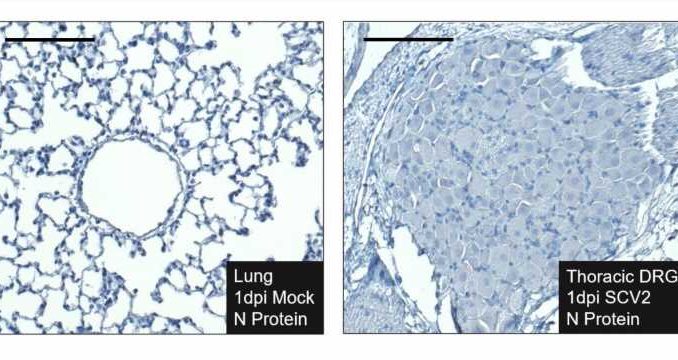

COVID-19, the disease resulting from SARS-CoV-2 infection, is associated with highly variable clinical outcomes that range from asymptomatic disease to death. For those with milder infections, COVID-19 can produce respiratory infection symptoms (cough, congestion, fever) and sensory phenotypes such as headache and loss of sense of smell.
In more severe cases, SARS-CoV-2 infection can affect nearly every organ and result in strokes from vascular occlusion, cardiovascular damage and acute renal failure. A substantial number of actively infected patients suffering from both mild and severe infections experience sensory-related symptoms, such as headache, visceral pain, Guillain-Barre syndrome, nerve pain and inflammation. In most patients these symptoms subside after the infection ends, but, for other patients, they can persist.
In a new study, researchers from Boston University Chobanian & Avedisian School of Medicine, Icahn School of Medicine at Mount Sinai (Icahn Mount Sinai) and New York University (NYU), have found that thousands of genes were affected by SARS-CoV-2-mediated disease even after the viral infection had been cleared.
These genes were associated with neurodegeneration and pain-related pathways, suggesting lasting damage to dorsal root ganglia (spinal nerves that carry sensory messages from various receptors) that may underlie symptoms of Post-COVID Conditions also known as Long COVID.
“Several studies have found that a high proportion of Long COVID patients suffer from abnormal perception of touch, pressure, temperature, pain or tingling throughout the body. Our work suggests that SARS-CoV-2 might induce lasting pain in a rather unique way, emphasizing the need for therapeutics that target molecular pathways specific to this virus,” explains corresponding author Venetia Zachariou, Ph.D., chair of pharmacology, physiology & biophysics at BU Chobanian & Avedisian School of Medicine.
This work was performed in collaboration with Benjamin tenOever, Ph.D., professor of microbiology and medicine at NYU, formerly at Icahn Mount Sinai.
Using an experimental model infected with SARS-CoV-2, the researchers studied the effects of infection on sensitivity to touch, both during active infection and well after the infection had cleared. They then compared the effects of SARS-CoV-2 to those triggered by influenza A virus infection.
In the experimental model, they observed a slow but progressive increase in sensory sensitivity over time—one that differed substantially from viral control, influenza A virus, which caused quick hypersensitivity during active infection but returned to normal by the time infection was over.
According to the researchers, this model can be used to gain information on genes and pathways affected by SARS-CoV-2, providing novel information to the scientific community on gene expression changes in sensory ganglia several weeks after infection.
“We hope this study will provide new avenues for addressing somatosensory symptoms of long COVID and ME/CFS (myalgic encephalomyelitis/chronic fatigue syndrome), which are only just now beginning to be addressed by mainstream medicine. While we have begun using this information by validating one promising target in this study, we believe our now publicly available data can yield insights into many new therapeutic strategies,” adds Zachariou.
These findings appear online in the journal Science Signaling.
More information:
SARS-CoV-2 airway infection results in the development of somatosensory abnormalities in a hamster model, Science Signaling (2023). DOI: 10.1126/scisignal.ade4984
Journal information:
Science Signaling
Source: Read Full Article